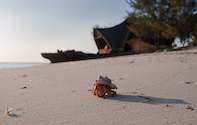
Towards the end of the stuffy hydro-foil crossing from Dar-es-Salaam, Tanzania, to Zanzibar Island, I stepped out onto the deck and was momentarily blinded by the brilliance of the turquoise Indian Ocean throwing the rays of the mid-afternoon sun back in my face. Blinking, I saw an island rising out of the waters to starboard, a dazzlingly white lighthouse and a huge palm-thatch roof towering above rocky cliffs and a dark green tangle of forest. It looked like Sydney Opera House on Robinson Crusoe's island.
When I arrived in Zanzibar, they told me the apparition I'd seen in the middle of the sea was Chumbe Island Coral Park, an eco-reserve and education centre for local schoolchildren. Now when I was a schoolkid, this kind of title conjured up images of a dank portakabin, fly-blown wallposters about leaves and soil formations, and dull nature walks through rainy fields.
Luckily for the nutmeg-coloured hordes that scamper down the streets of Zanzibar, Chumbe Island is nothing like this. Despite an impressive list of environmental credentials - Tanzania's first Marine National Park, winner of the British Airways Tourism for Tomorrow Award, home to 400 species of fish and 200 species of coral - Chumbe has no hint of worthiness.
And luckily for the rest of us, Chumbe is not just an education centre. It's also a tiny luxury hotel, the ultimate 'Castaway' fantasy - and we're not talking stroppy, wool-clad English folk shouting at each other about compost in the Orkneys.
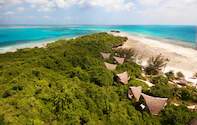
The rather unlikely combination of romantic barefoot luxury and primary education came about in the early nineties when Sybille Riedmiller, a sociologist and conservationist originally from Germany, began her campaign to develop Chumbe as a marine sanctuary and free education project. Back then, an economic boom meant mass tourism projects were springing up all over Tanzania and the government wasn't interested in conservation, only large-scale development.
Riedmiller was forced to sell her idea as a tourist development, and after seven long years of struggling with bureaucracy and raising funds from around the world, Chumbe is now recognised as one of the world's most forward-looking and successful eco-tourism projects.
My second view of Chumbe Island was slightly less prepossessing than the first. As the small boat they'd sent to fetch me chug-chugged its way towards the island, black storm clouds began to form ominously above it. As we got nearer, the sea got choppier and large, warm drops of rain began to fall. By the time we arrived, I was soaked to the skin, the palm trees were swaying in the wind like demented dancers and, stumbling up the beach, I felt like Robinson Crusoe washed up on an unknown shore.
Standing dripping under the shelter of that magnificent roof, I learnt more about the structures on Chumbe - the lighthouse keeper's house, now converted into the visitor's centre, a crumbling mosque, still used by the island's employees, and, of course, that lighthouse, put there by the British in 1904 and still functioning.
The visitors' centre has a classroom with gaily-coloured paintings of fish, rows of tiny rubber shoes for walks in the forest and letters from previous visitors saying things like, 'I hope your coral is still OK, love Fatima aged 8'.
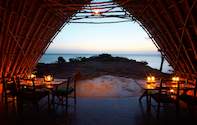
But the best thing about Chumbe is the bandas. A narrow, sandy path leads to your own, private, Tarzan-and-Jane fantasy house. Seashells line the driftwood steps into the living room and on a smooth turquoise floor, white tiles pick out the shape of a crab.
Everything is propped up, lashed together, woven out of grass, or made of flotsam and jetsam. Hanging from the ceiling, a rope hammock full of brightly coloured cushions swings in the sea breeze.
There is no garden fence, not even much in the way of walls, but the green, tangled jungle creepers that surround the place on all sides cut off all hint of other people - you might be utterly alone with the roar of the surf. Strange, exotic birds fly into the trees that surround you and peer in, cocking their heads inquisitively.
The banda roofs have been specially designed to catch rainwater, which is channelled through filters and into a tank under the floor, then hand-pumped across solar panels into the bathroom. Grey water from the showers is released into sealed flower beds around the outside of the building, containing plants chosen for their ability to take up phosphates and oxides from the soil so that nothing is wasted. The lights are also solar powered, and instead of flushing the loo, a polite notice asks you to throw in sweet-smelling compost ('two scoops') from a handily placed basket.
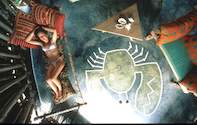
The upper deck of the banda creaks as you climb the ladder to the bedroom - or rather bed platform. Tiny spots of sunlight filter through the palm thatch of the roof, spangling the white gauze of a huge four-square mosquito net and making patterns across the mattress on the floor.
Hooks have been whittled from twigs for your clothes, and shelves are made from driftwood planks, fastened together and suspended from the wall with coconut-fibre rope. Looking out towards the sea, the front wall of the bedroom acts as air conditioning and window combined - lower it with a rope, and you can lie in bed and gaze at the sky.
This is state-of-the-art eco-architecture with a touch of salvage chic.
By the time I'd finished scampering round my banda and whimpering with excitement, the sun had come out again and it was time for lunch. There are only seven bandas on Chumbe, allowing 14 guests at a time, so there's no real need for a proper restaurant, just some tables and chairs outside by the sea, and Salim the kindly waiter to bring out steaming pottery dishes of spiced kingfish and coconut rice.
Almost all the staff on Chumbe are local Zanzibaris from the fishing community, retrained as 'marine rangers', who spend two weeks on the island and then one week back in their villages, educating their neighbours about sustainable fishing methods. Catches, which have been steadily declining in Zanzibar over the past few years due to overfishing, are reported to be levelling out.
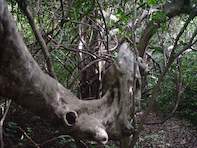
After lunch Khamis the head ranger led me through the forest that covers Chumbe, holding aside trailing creepers and pointing out the initials carved by British sailors on a huge baobab tree, and the date - 1942. The baobab was already old by then - it's been growing here for 500 years. Its roots climb down into an intertidal pool, inky and dank-smelling, and mingle with the roots of the black mangrove trees that grow up through the water.
Like most of the species on Chumbe Island, the black mangrove has adapted to an unpromising environment. To maximise oxygen intake, its roots grow up out of the ground and form 'noses' that stick out of the soil for a breath of air.
Mangrove seeds are long and pointed, weighted at one end so they'll fall vertically and start to take root immediately if they find themselves in soil. If they fall into water, they float, sometimes up to 200 km without rotting, until they find a more promising place to grow.
Chumbe's forest also provides a sanctuary for the endangered Ader's duiker, a small antelope also found in the Jozani Forest reserve in the centre of Zanzibar Island. Studies were carried out which showed the forest habitat on Chumbe Island to be ideal for the duiker, and several adults were relocated by boat from Jozani to the island to start a new colony.
Periodically, as we picked our way through damp loam and fallen leaf matter, trying to avoid the drips from the tree canopy above us, we come across a neat square of string on the forest floor, and some plastic labels on which notes had been scrawled in waterproof ink.
As well as its unique mixture of plant, fish and coral life, the island also supports a small seasonal colony of American biologists and college students, who live in gaily-coloured tents and come out early in the morning to measure and record the progress of the forest or the reef.

I barely had a chance to doze off in my hammock before the tide was in and the time was ripe for snorkelling over Chumbe's coral reef - described by Professor Charlie Veron, chief scientist at the Australian Institute of Marine Science, as 'one of the most spectacular coral gardens to be found anywhere in the world'.
I floated for hours, entranced, above a science-fiction world of green and blue forests, valleys of puce, spiky trees and plains of yellow feathery grass. Outlandishly coloured and patterned fish pottered busily around, nibbling fussily at the coral garden or grazing in herds, like cows.
The stillness was so complete I could hear the sounds they made with each mouthful as they cropped at choice tentacles. A huge, impossibly patterned lobster moved slowly across the sea bed, waving feelers a foot long at the tiny purple jellyfish that floated along the surface and bumped against my mask.
An underwater field guide, floating from a rubber ring, gave the fish names as outlandish as their appearance - Golden Trumpetfish (long and tubular), Goldsaddle Goatfish (with beard), Bullethead Parrotfish (belligerent and beaked), Picasso Triggerfish (appears to be made out of bits of other fish) and lastly, lugubriously staring - Bigeye.
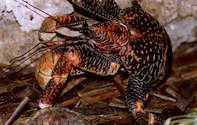
Later, after a dinner lit by flickering candles in jars and accompanied by the sound of the sea, Khamis took me out looking for coconut crabs. These are the world's biggest land-dwelling crustacea, endangered in much of the world, shy and nocturnal. They start their lives in the sea as humble hermit crabs, then leave their borrowed shells behind, grow until they weigh up to 4kg, and start to feed on coconuts that have fallen from trees, cracking them open with enormous claws. If coconuts get a bit scarce on the ground, they are said to climb the palm trees and snap off the fruit at the top.
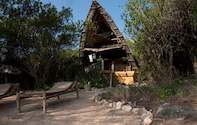
After an hour of fruitless searching, I was about to give up when the beam from my torch landed on a claw of monstrous proportions, waving gently at me from inside a clump of undergrowth. I stopped in my tracks, and the crab crawled slowly into view, one great leg after another moving deliberately across the sandy path inches from my feet. Its body was deep red, patterned with black wavy lines, and more like a lobster in shape than the conventional 'sideways' crab.
It was beautiful and at the same time, rather horrifying, and I was contemplating flight when a ranger appeared out of the darkness and unhesitatingly scooped it up to show me the white abdomen glistening in the torchlight and claws waving in impotent fury.
Placed at the bottom of a palm tree, it had an affronted air as the huge legs wrapped themselves around the trunk and started to inch upwards. We left it in peace after 50 feet, still moving inexorably onwards in search of dinner.
Finally, under my mosquito canopy, surrounded by squeakings and rustlings from the jungle around the bed, I lowered my personal portcullis and lay gazing at the stars, caught in the ragged tops of the palm trees as they danced in the night wind to the soft tune of the sea. All I needed now was Tarzan.
Chumbe Fact File
Getting there
Chumbe Island is located 8km south west of Zanzibar Town, a journey of around 40 minutes by boat. Zanzibar Island is a two-hour ferry journey from the Tanzanian mainland, and fast ferries make the trip four or five times a day in both directions. International carriers including Kenya Airways, Ethiopian Airlines and Gulf Air fly from the UK to Zanzibar airport, while British Airways flies to Dar-es-Salaam via Nairobi. Prices start at around 400 pounds.
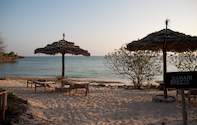
When to go
Zanzibar is a year-round destination, but daily rain showers can be expected during the short rains - November to December, and the long rains - April to June. Temperatures vary between 30ûC in the dry season and 25ûC during the rains.
What to Bring
Adequate sun protection, including t-shirt for snorkelling. Shoes suitable for wading on and off boats across sharp rocks. High-quality mosquito repellent - Zanzibar is a malaria-risk area. Consult your doctor before leaving for immunisations and malaria prophylaxis. Visitors planning to combine a trip to Chumbe Island with a stay on Zanzibar Island should be aware that 95% of the island's population are Muslim and modest dress is encouraged.
Copyright © Gemma Pitcher 2004, Images © Manolo Yllera

 Zanzibar has many offshore islands, many of which provide a stunning location for a day trip or a longer stay. Boats to any of the islands o...
Zanzibar has many offshore islands, many of which provide a stunning location for a day trip or a longer stay. Boats to any of the islands o...